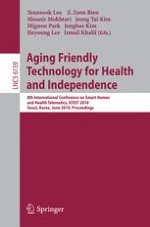We are living in a world full of innovations for the elderly and people with special needs to use smart assistive technologies and smart homes to more easily perform activities of daily living, to continue in social participation, to engage in entertainment and leisure activities, and to enjoy living independently. These innovations are inspired by new technologies leveraging all aspects of ambient and pervasive intel- gence with related theories, technologies, methods, applications, and services on ub- uitous, pervasive, AmI, universal, mobile, embedded, wearable, augmented, invisible, hidden, context-aware, calm, amorphous, sentient, proactive, post–PC, everyday, autonomic computing from the engineering, business and organizational perspectives. In the field of smart homes and health telematics, significant research is underway to enable aging and disabled people to use smart assistive technologies and smart homes to foster independent living and to offer them an enhanced quality of life. A smart home is a vision of the future where computers and computing devices will be available naturally and unobtrusively anywhere, anytime, and by different means in our daily living, working, learning, business, and infotainment environments. Such a vision opens tremendous opportunities for numerous novel services/applications that are more immersive, more intelligent, and more interactive in both real and cyber spaces.
